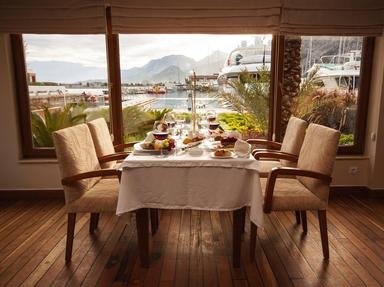Quiz Answer Key and Fun Facts
1. In which country would I find Chef Emmanuel Renaut's Michelin three-star restaurant serving a filet of chamois (a mountain goat-antelope) with a blueberry shallot purée and little truffle tarts? It is the one where the Michelin star rating system was developed.
2. To which of European country would I go to eat Namur snails, marrow, cecina (air-dried beef), potato and buttermilk prepared by Chef Peter Goossens in his Michelin three-star restaurant?
3. Where would I find a Michelin three-star restaurant with Chef Massimo Bottura amazing us with an appetiser entitled "An eel swimming up the Po River"?
4. I am dreaming of Chef Dominique Crenn's dessert blending Bay Area beeswax sorbet with honey meringue, roasted white chocolate, pistachio purée, candied pistachio and Asian pears. Where would I find her three-star Michelin restaurant?
5. I would love to eat in the Michelin three-star Scandinavian restaurant of Chef Esben Holmboe Bang and to try his mahogany clams and shiitake mushrooms from Telemark with crispy chicken skins and a seaweed broth. Can you guess its location?
6. In which Michelin three-star restaurant would I find Chef Eneko Atxa serving a dish that looks like an avocado pit, but is a crisp bread soufflé stuffed with guacamole and wrapped in Iberian ham?
7. I dream of finding myself in a three-star Michelin restaurant in a building that once housed a pub, eating a dish by Chef Hestor Blumenthal, "Sounds of the Sea" made of edible tapioca sand, baby eels, abalone, razor clams, shrimps, oysters and three kinds of seaweed, all accompanied by music coming from inside a conch shell? Where would I be?
8. In which country would I need courage to enter a Michelin three-star restaurant specializing in a single ingredient, pufferfish, one of the deadliest fish in the world, even if it is prepared by an expert Chef Yoshio Kusakabe?
9. Where in the world would I be delighted to taste teaweed crab Melba paired with a Lagavulin whiskey and lapsang souchong iced tea prepared by Chef Paul Pairet in his Michelin three-star restaurant?
10. If I wanted to eat confit trout, poutargue soup with lotte from Lake Annecy and Beluga lentils prepared by Chef Laurent Petit, I could reserve a table at a Michelin three-star restaurant in which country?
Source: Author
pitegny
This quiz was reviewed by FunTrivia editor
WesleyCrusher before going online.
Any errors found in FunTrivia content are routinely corrected through our feedback system.
